remove seats RENAULT CLIO 2009 X85 / 3.G Owners Manual
[x] Cancel search | Manufacturer: RENAULT, Model Year: 2009, Model line: CLIO, Model: RENAULT CLIO 2009 X85 / 3.GPages: 264, PDF Size: 15.68 MB
Page 26 of 264
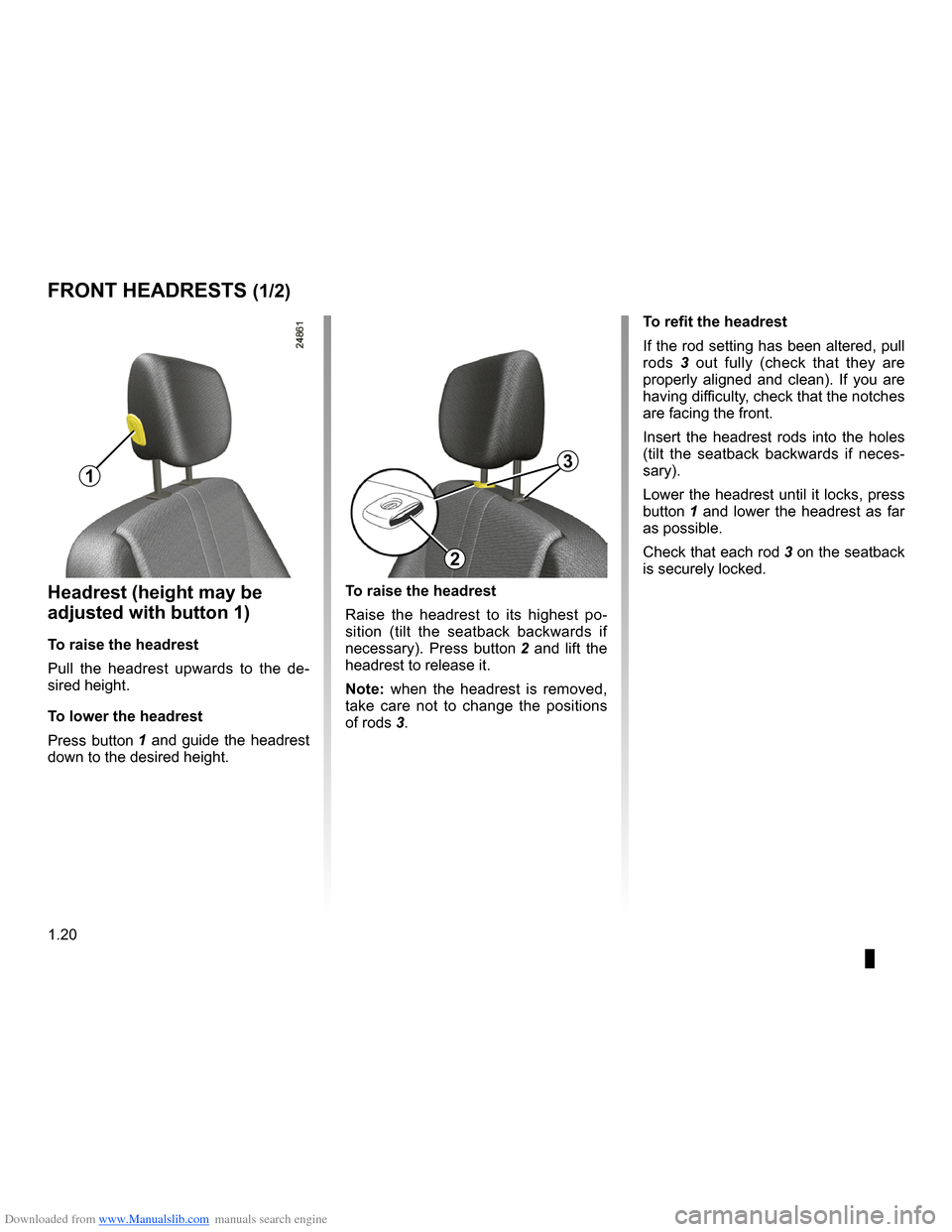
Downloaded from www.Manualslib.com manuals search engine
headrest................................................(up to the end of the DU)adjusting your driving position ..............(up to the end of the DU)
1.20
ENG_UD15288_2Appuis-tête avant (X85 - B85 - C85 - S85 - K85 - Renault)ENG_NU_853-3_BCSK85_Renault_1
JauneNoirNoir texte
Headrests - Seats
To refit the headrest
If the rod setting has been altered, pull rods 3 out fully (check that they are properly aligned and clean). If you are having difficulty, check that the notches are facing the front.
Insert the headrest rods into the holes (tilt the seatback backwards if neces- sary).
Lower the headrest until it locks, press
button 1 and lower the headrest as far as possible.
Check that each rod
3 on the seatback is securely locked.
FRONT HEADRESTS (1/2)
1
2
3
Headrest (height may be
adjusted with button 1)
To raise the headrest
Pull the headrest upwards to the de- sired height.
To lower the headrest
Press button
1 and guide the headrest
down to the desired height.
To raise the headrest
Raise the headrest to its highest po- sition (tilt the seatback backwards if
necessary). Press button 2 and lift the headrest to release it.
Note: when the headrest is removed, take care not to change the positions
of rods 3.
Page 29 of 264
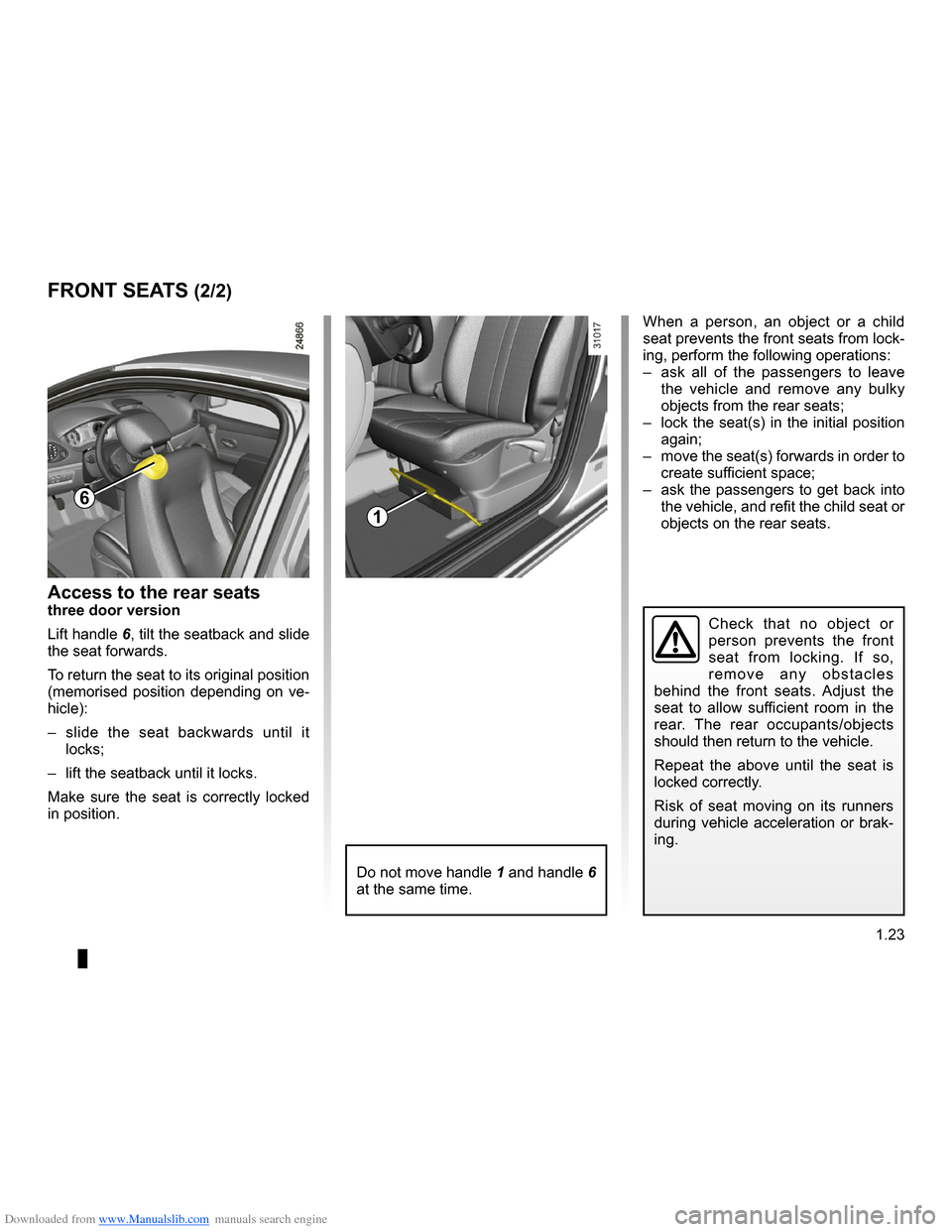
Downloaded from www.Manualslib.com manuals search engine
JauneNoirNoir texte
1.23
ENG_UD14659_2Sièges avant (X85 - B85 - C85 - S85 - K85 - Renault)ENG_NU_853-3_BCSK85_Renault_1
Access to the rear seatsthree door version
Lift handle 6, tilt the seatback and slide the seat forwards.
To return the seat to its original position (memorised position depending on ve- hicle):
– slide the seat backwards until it
locks;
– lift the seatback until it locks.
Make sure the seat is correctly locked in position.
FRONT SEATS (2/2)
6
When a person, an object or a child seat prevents the front seats from lock- ing, perform the following operations:
– ask all of the passengers to leave the vehicle and remove any bulky objects from the rear seats;
– lock the seat(s) in the initial position again;
– move the seat(s) forwards in order to create sufficient space;
– ask the passengers to get back into the vehicle, and refit the child seat or objects on the rear seats.1
Do not move handle 1 and handle 6 at the same time.
Check that no object or person prevents the front seat from locking. If so, r e m o v e a n y o b s t a c l e s behind the front seats. Adjust the seat to allow sufficient room in the rear. The rear occupants/objects should then return to the vehicle.
Repeat the above until the seat is locked correctly.
Risk of seat moving on its runners during vehicle acceleration or brak- ing.
Page 30 of 264
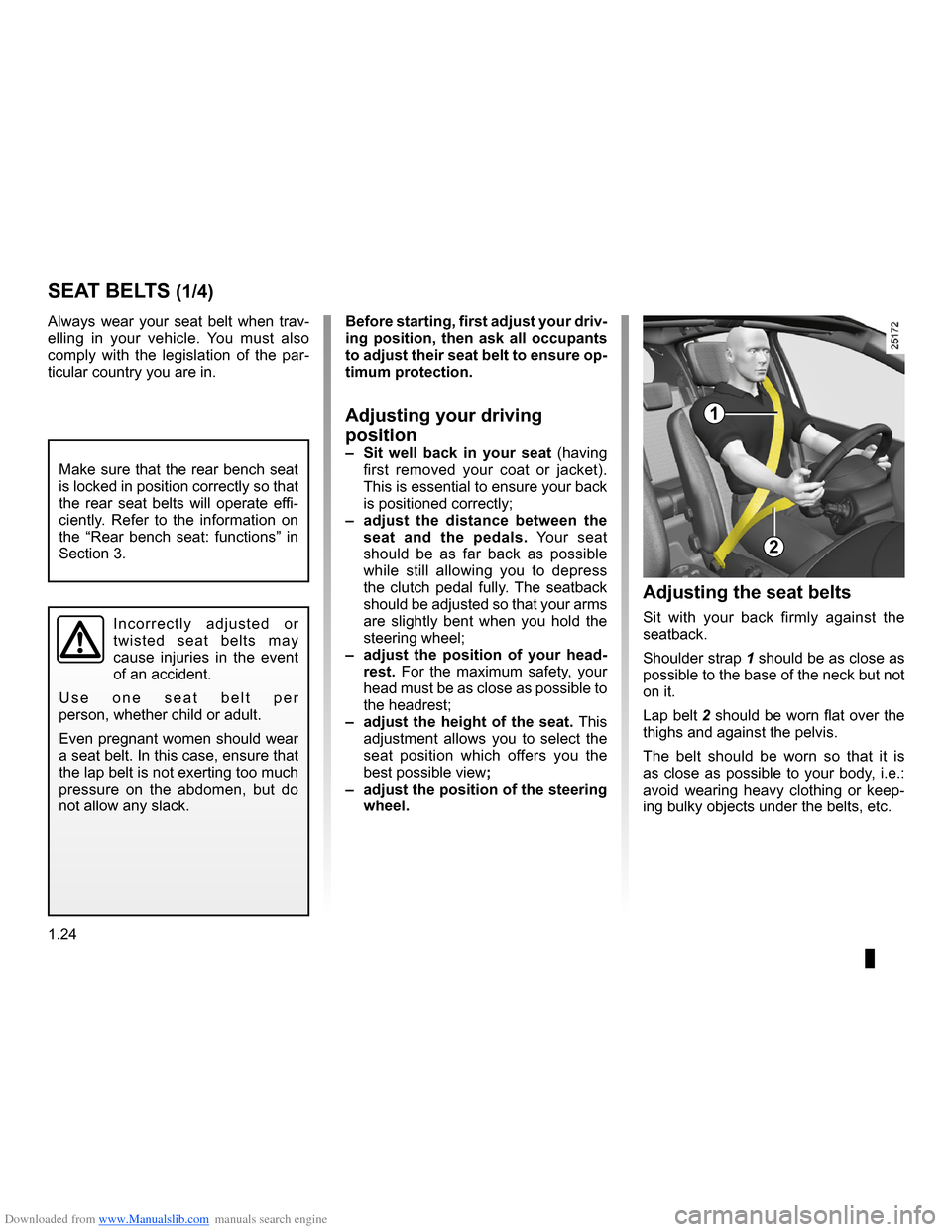
Downloaded from www.Manualslib.com manuals search engine
seat belts ..............................................(up to the end of the DU)adjusting your driving position ..............(up to the end of the DU)front seatsadjustment .......................................................(current page)driving positionsettings ...........................................(up to the end of the DU)
1.24
ENG_UD14660_3Ceintures de sécurité (X85 - B85 - C85 - S85 - K85 - Renault)ENG_NU_853-3_BCSK85_Renault_1
JauneNoirNoir texte
Always wear your seat belt when trav- elling in your vehicle. You must also comply with the legislation of the par- ticular country you are in.
Seat belts
SEAT BELTS (1/4)
1
2
I n c o r r e c t l y a d j u s t e d o r twisted seat belts may cause injuries in the event of an accident.
U s e o n e s e a t b e l t p e r person, whether child or adult.
Even pregnant women should wear
a seat belt. In this case, ensure that the lap belt is not exerting too much pressure on the abdomen, but do not allow any slack.
Before starting, first adjust your driv- ing position, then ask all occupants to adjust their seat belt to ensure op- timum protection.
Adjusting your driving
position– Sit well back in your seat (having first removed your coat or jacket). This is essential to ensure your back is positioned correctly;
– adjust the distance between the seat and the pedals. Your seat should be as far back as possible while still allowing you to depress the clutch pedal fully. The seatback should be adjusted so that your arms are slightly bent when you hold the steering wheel;
– adjust the position of your head- rest. For the maximum safety, your head must be as close as possible to the headrest;
– adjust the height of the seat. This adjustment allows you to select the
seat position which offers you the best possible view;– adjust the position of the steering wheel.
Adjusting the seat belts
Sit with your back firmly against the seatback.
Shoulder strap
1 should be as close as possible to the base of the neck but not on it.
Lap belt
2 should be worn flat over the thighs and against the pelvis.
The belt should be worn so that it is as close as possible to your body, i.e.: avoid wearing heavy clothing or keep- ing bulky objects under the belts, etc.
Make sure that the rear bench seat is locked in position correctly so that the rear seat belts will operate effi- ciently. Refer to the information on the “Rear bench seat: functions” in Section 3.
Page 45 of 264
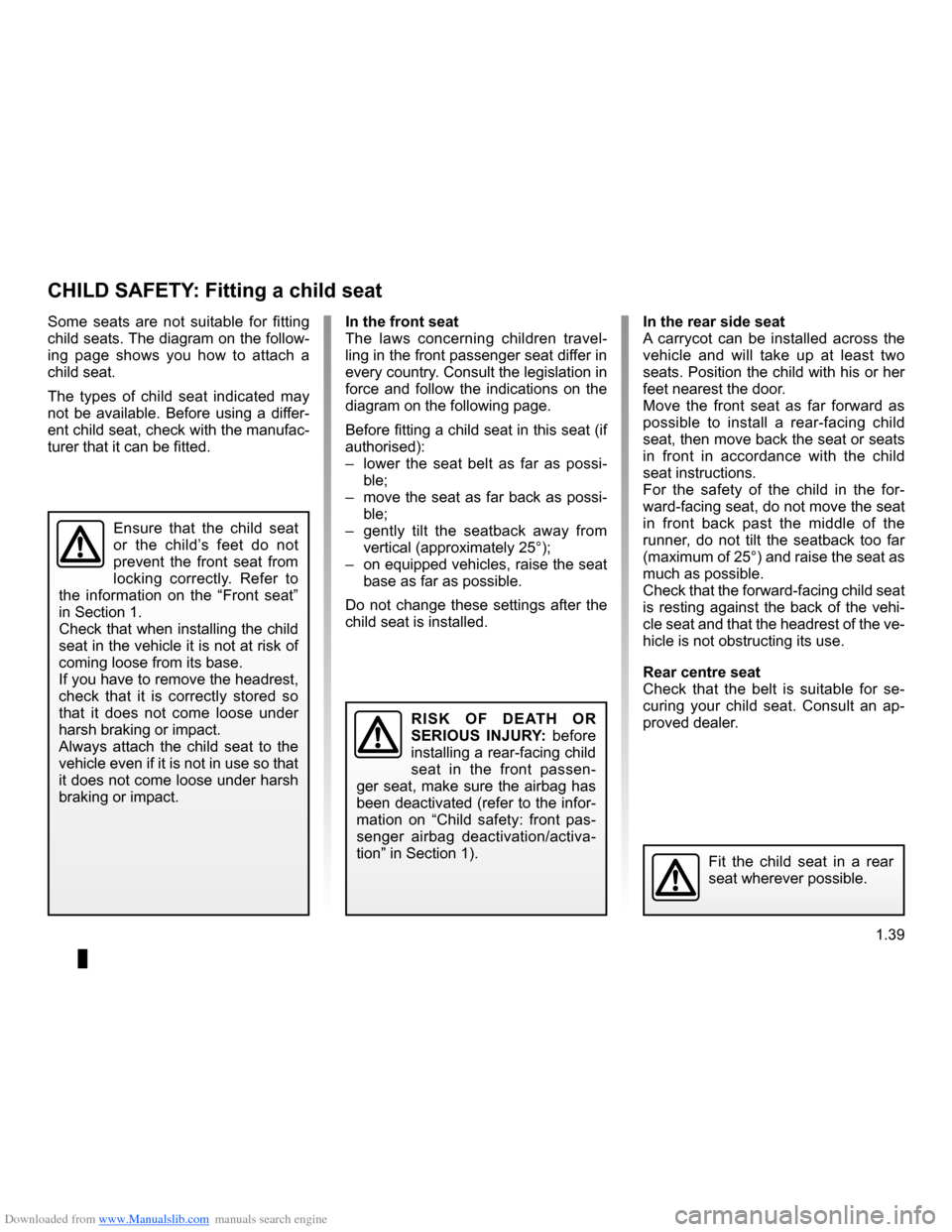
Downloaded from www.Manualslib.com manuals search engine
child restraint/seat ................................(up to the end of the DU)child restraint/seat ................................(up to the end of the DU)child restraint/seat ................................(up to the end of the DU)child safety............................................(up to the end of the DU)child seats.............................................(up to the end of the DU)transporting children .............................(up to the end of the DU)
1.39
ENG_UD13297_2Sécurité enfants : installation du siège enfant (X85 - B85 - C\
85 - S85 - K85 - Renault)ENG_NU_853-3_BCSK85_Renault_1
Fitting a child seat
CHILD SAFETY : Fitting a child seat
Some seats are not suitable for fitting child seats. The diagram on the follow- ing page shows you how to attach a child seat.
The types of child seat indicated may not be available. Before using a differ- ent child seat, check with the manufac- turer that it can be fitted.
Ensure that the child seat or the child’s feet do not prevent the front seat from locking correctly. Refer to the information on the “Front seat” in Section 1.Check that when installing the child seat in the vehicle it is not at risk of coming loose from its base.If you have to remove the headrest, check that it is correctly stored so that it does not come loose under harsh braking or impact.Always attach the child seat to the
vehicle even if it is not in use so that it does not come loose under harsh braking or impact.
In the front seatThe laws concerning children travel- ling in the front passenger seat differ in every country. Consult the legislation in force and follow the indications on the diagram on the following page.
Before fitting a child seat in this seat (if authorised):
– lower the seat belt as far as possi- ble;
– move the seat as far back as possi- ble;
– gently tilt the seatback away from vertical (approximately 25°);
– on equipped vehicles, raise the seat base as far as possible.
Do not change these settings after the child seat is installed.
In the rear side seatA carrycot can be installed across the vehicle and will take up at least two seats. Position the child with his or her feet nearest the door.Move the front seat as far forward as possible to install a rear-facing child seat, then move back the seat or seats in front in accordance with the child seat instructions.For the safety of the child in the for- ward-facing seat, do not move the seat in front back past the middle of the runner, do not tilt the seatback too far (maximum of 25°) and raise the seat as much as possible.Check that the forward-facing child seat is resting against the back of the vehi- cle seat and that the headrest of the ve- hicle is not obstructing its use.
Rear centre seatCheck that the belt is suitable for se- curing your child seat. Consult an ap- proved dealer.R I S K O F D E AT H O R SERIOUS INJURY: before installing a rear-facing child seat in the front passen- ger seat, make sure the airbag has been deactivated (refer to the infor- mation on “Child safety: front pas- senger airbag deactivation/activa- tion” in Section 1).Fit the child seat in a rear seat wherever possible.
Page 49 of 264
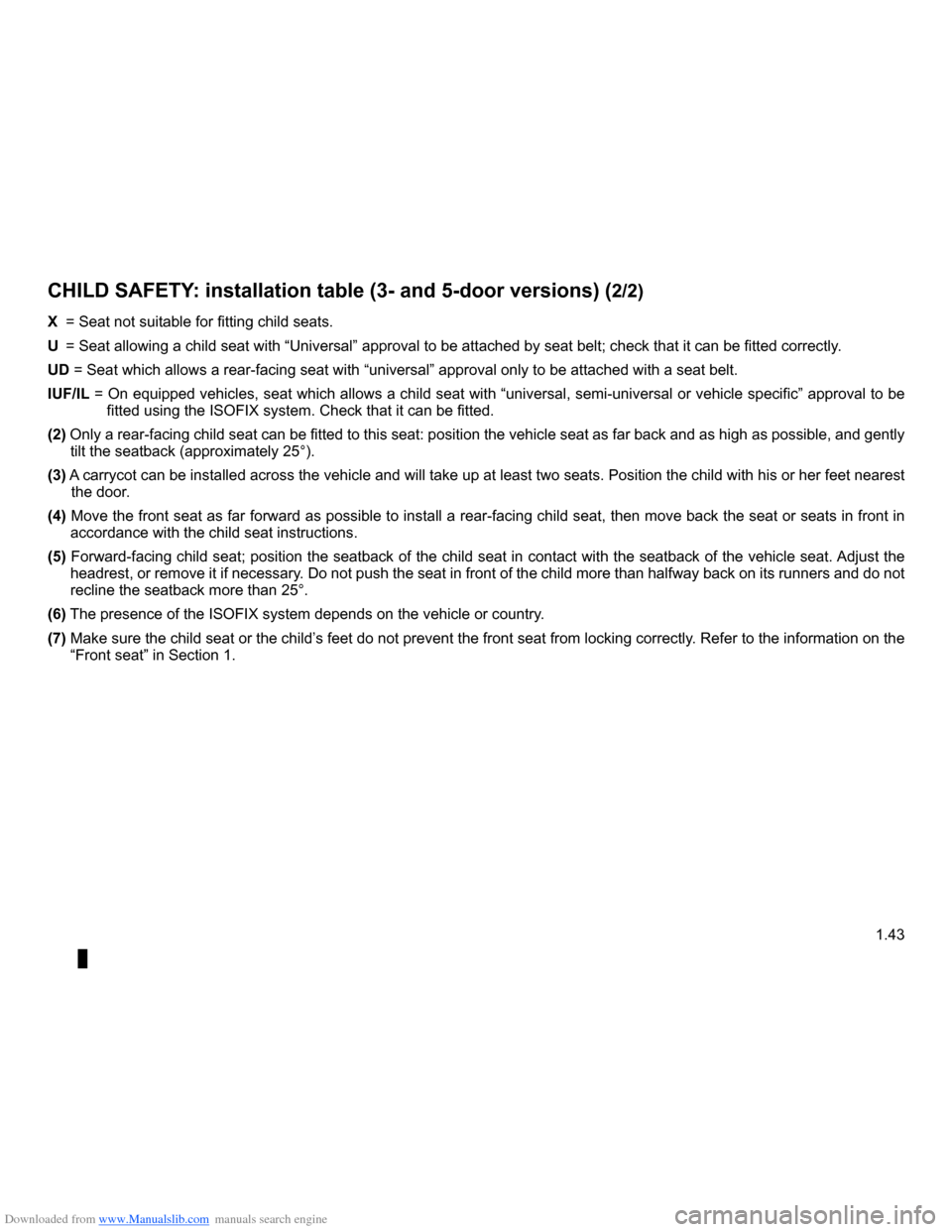
Downloaded from www.Manualslib.com manuals search engine
JauneNoirNoir texte
1.43
ENG_UD13297_2Sécurité enfants : installation du siège enfant (X85 - B85 - C\
85 - S85 - K85 - Renault)ENG_NU_853-3_BCSK85_Renault_1
CHILD SAFETY: installation table (3- and 5-door versions) (2/2)
X = Seat not suitable for fitting child seats.
U
= Seat allowing a child seat with “Universal” approval to be attached by seat belt; check that it can be fitted correctly.
UD = Seat which allows a rear-facing seat with “universal” approval \
only to be attached with a seat belt.
IUF/IL =
On equipped vehicles, seat which allows a child seat with “universal, semi-universal or vehicle specific” approval to be fitted using the ISOFIX system. Check that it can be fitted.
(2)
Only a rear-facing child seat can be fitted to this seat: position the vehicle seat as far back and as high as possible, and gently tilt the seatback (approximately 25°).
(3)
A carrycot can be installed across the vehicle and will take up at least two seats. Position the child with his or her feet nearest the door.
(4)
Move the front seat as far forward as possible to install a rear-facing child seat, then move back the seat or seats in front in accordance with the child seat instructions.
(5)
Forward-facing child seat; position the seatback of the child seat in contact with the seatback of the vehicle seat. Adjust the headrest, or remove it if necessary. Do not push the seat in front of the child more than halfway back on its runners and do not recline the seatback more than 25°.
(6) The presence of the ISOFIX system depends on the vehicle or country.
(7)
Make sure the child seat or the child’s feet do not prevent the front seat from locking correctly. Refer to the information on the “Front seat” in Section 1.
Page 51 of 264
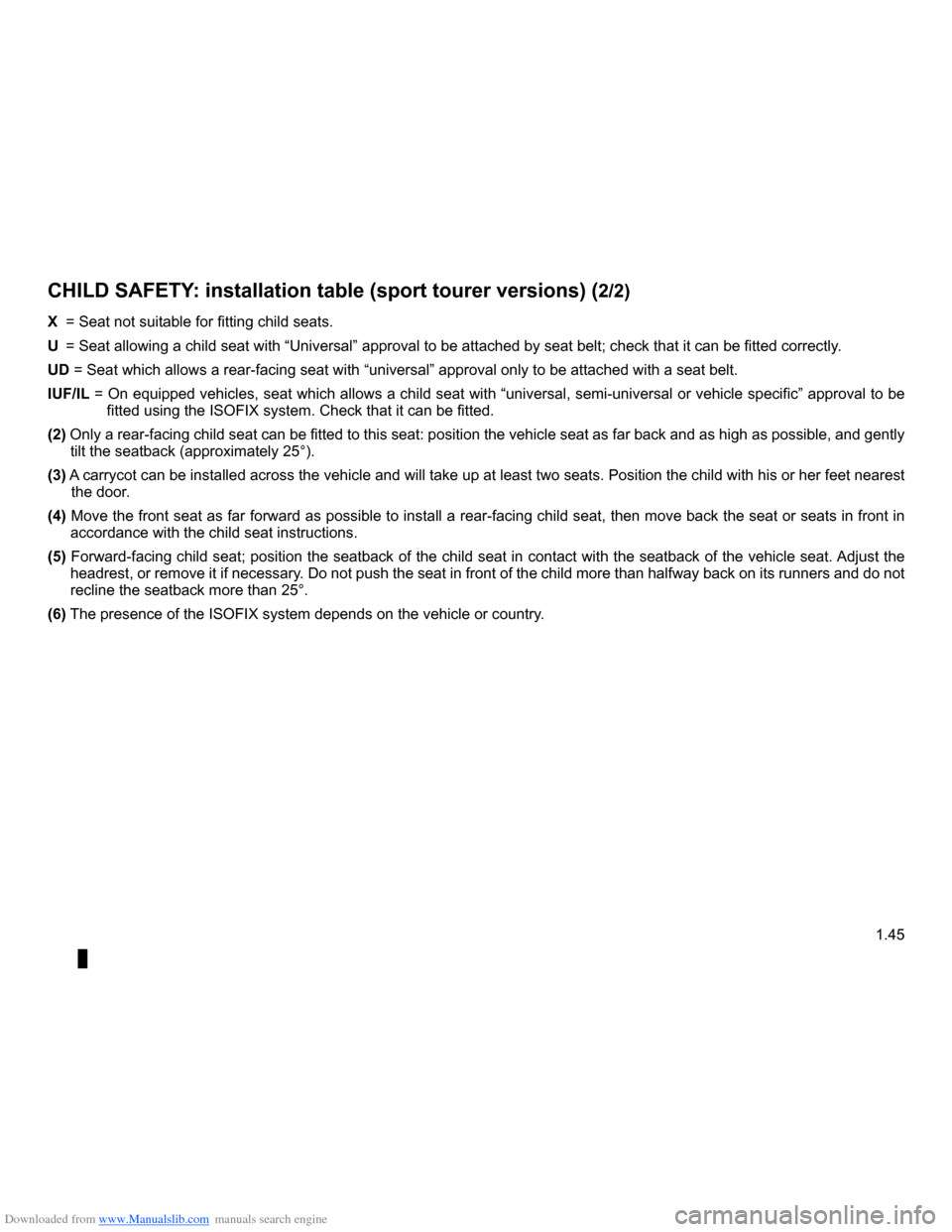
Downloaded from www.Manualslib.com manuals search engine
JauneNoirNoir texte
1.45
ENG_UD13297_2Sécurité enfants : installation du siège enfant (X85 - B85 - C\
85 - S85 - K85 - Renault)ENG_NU_853-3_BCSK85_Renault_1
CHILD SAFETY: installation table (sport tourer versions) (2/2)
X = Seat not suitable for fitting child seats.
U
= Seat allowing a child seat with “Universal” approval to be attached by seat belt; check that it can be fitted correctly.
UD = Seat which allows a rear-facing seat with “universal” approval \
only to be attached with a seat belt.
IUF/IL =
On equipped vehicles, seat which allows a child seat with “universal, semi-universal or vehicle specific” approval to be fitted using the ISOFIX system. Check that it can be fitted.
(2)
Only a rear-facing child seat can be fitted to this seat: position the vehicle seat as far back and as high as possible, and gently tilt the seatback (approximately 25°).
(3)
A carrycot can be installed across the vehicle and will take up at least two seats. Position the child with his or her feet nearest the door.
(4)
Move the front seat as far forward as possible to install a rear-facing child seat, then move back the seat or seats in front in accordance with the child seat instructions.
(5)
Forward-facing child seat; position the seatback of the child seat in contact with the seatback of the vehicle seat. Adjust the headrest, or remove it if necessary. Do not push the seat in front of the child more than halfway back on its runners and do not recline the seatback more than 25°.
(6) The presence of the ISOFIX system depends on the vehicle or country.
Page 162 of 264
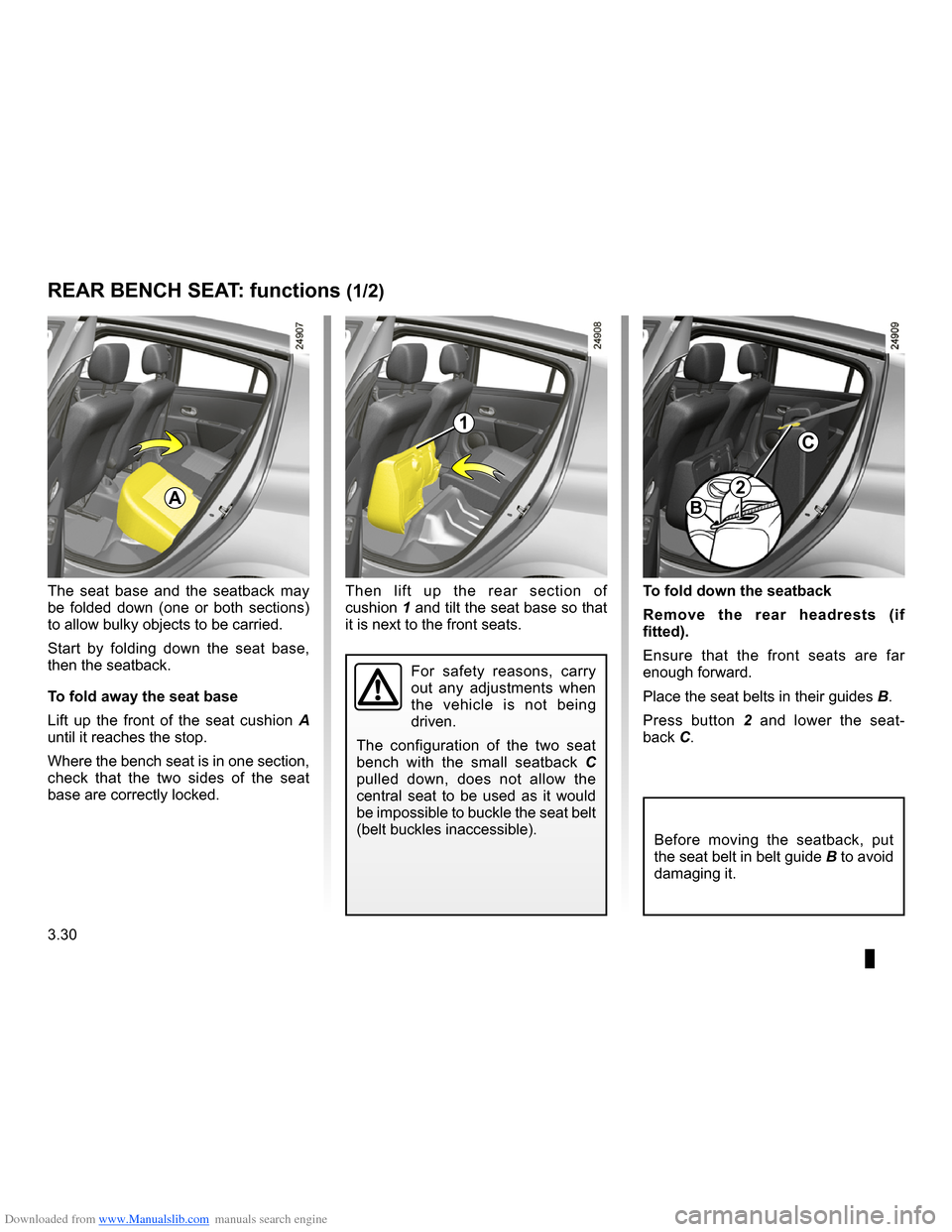
Downloaded from www.Manualslib.com manuals search engine
rear bench seat.....................................(up to the end of the DU)rear seatsfunctions .........................................(up to the end of the DU)
3.30
ENG_UD10581_1Banquette arrière : fonctionnalités (X85 - B85 - C85 - S85 - K85 \
- Renault)ENG_NU_853-3_BCSK85_Renault_3
JauneNoirNoir texte
Then lift up the rear section of cushion 1 and tilt the seat base so that it is next to the front seats.
To fold down the seatback
Remove the rear headrests (if fitted).
Ensure that the front seats are far enough forward.
Place the seat belts in their guides
B.
Press button 2 and lower the seat-
back C.
Rear bench seat: functions
Before moving the seatback, put the seat belt in belt guide B to avoid damaging it.
For safety reasons, carry out any adjustments when the vehicle is not being driven.
The configuration of the two seat bench with the small seatback C pulled down, does not allow the central seat to be used as it would be impossible to buckle the seat belt (belt buckles inaccessible).
The seat base and the seatback may be folded down (one or both sections) to allow bulky objects to be carried.
Start by folding down the seat base, then the seatback.
To fold away the seat base
Lift up the front of the seat cushion A until it reaches the stop.
Where the bench seat is in one section, check that the two sides of the seat base are correctly locked.
REAR BENCH SEAT: functions (1/2)
A
1
C
B
2
Page 169 of 264

Downloaded from www.Manualslib.com manuals search engine
tailgate ..................................................(up to the end of the DU)transporting objectsin the luggage compartment ...........(up to the end of the DU)
3.37
ENG_UD14667_3Transports d objets dans le coffre (X85 - B85 - C85 - S85 - K85 - Renault)ENG_NU_853-3_BCSK85_Renault_3
Transporting objects in the luggage compartment
Always position the heavi- est items directly on the floor. Use the lashing points on the floor of the luggage compartment, if these are fitted to the vehicle. The luggage should be loaded in such a way that no items will be thrown forward and strike the occupants if the driver has to brake suddenly. Fasten the rear seat belts, even if the seats are not occupied.
If you have to place objects on the folded seatback, with the bench seat in the 3-seater position, remove the front headrests before folding the seatback so that is can be folded as flat as pos- sible against the seat base.
TRANSPORTING OBJECTS IN THE LUGGAGE COMPARTMENT
Always position the objects transported so that the largest surface is against:
– The rear bench seatback for normal
loads (example A).
– The folded down seat for maximum
loads (example B).
A
B